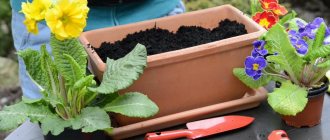Primroses begin to bloom immediately after the snow melts, saturating the garden with incredible colors. Primula Akaulis is a type of crop that can be grown not only on the street, but also at home. To achieve long and beautiful flowering, it is necessary to recreate the conditions prevailing in the natural habitat of the primrose.
Primula "Akaulis" - one of the earliest flowers in the garden
Description of the plant
Primrose is common on all continents, but most of its varieties grow in Asian countries: China, Korea, Japan. In Russia, this plant is also known as primrose.
Primula acaulis is short-stemmed. It is also sometimes called stemless because of its small size: the height reaches only 20 cm. The plant forms a rosette at the very root: leaves grow from it, covered with small thin hairs. They have an elongated shape and are bright green in color.
Primrose blooms in spring and continues until mid-summer. At the same time, peduncles are formed from the rosette, on which five-membered flowers of regular shape bloom. Their size ranges from 25-40 mm. In the second half of July, fruit boxes begin to form.
Attention!
It is impossible to guess the color of the petals of primrose acaulis mix in advance, since the seeds of plants with different flower colors are mixed in the bag. It comes in white, blue with a purple tint, and bright yellow, as in the photo below.
Indoor types of primrose
Primrose has long been loved by gardeners and has become one of the most popular plants in our flower beds. However, in indoor culture it is quite rare and is represented here by only three species.
Soft primrose (Primula malacoides), whose homeland is the Chinese province of Yunnan, is a perennial medium-sized rosette plant, in its natural habitat reaching 30 cm in diameter and 20 - 40 cm in height. The leaves are long-petiolate (petiole up to 8 cm), soft, pale green, elongated-oval with a heart-shaped base and jagged edge, 2–8 cm long.
The flowering time occurs at the beginning of spring and lasts up to three (and sometimes more) months. The peduncles are numerous, tall, erect, bearing loose multi-level paniculate inflorescences, 10–20 flowers each. The corolla is wide open, with a flat bend, about 4 cm in diameter. In the natural species, it has a purple color with a yellow pharynx, but breeders have obtained numerous varieties with white, pink and red flowers and a yellow core that extends far beyond the pharynx.
Among the varieties of P. malacoides, the most popular are the following:
– 'Snow Queen' and 'White Pearl' – with white flowers; – 'Delight' – soft pink flowers; – 'Fire Chief', 'Ninette' and 'Jubilee' – bright red flowers; – 'Lilac Queen' – purple flowers; – 'Mars' – purple flowers; – 'Enchantment' – blue flowers; – 'Springtide Mixed' – pastel colored flowers; – 'Juliet Mixed' is a double-colored, two-color variety with pastel-colored petals and a lilac-pink border.
Primula obconical, or oblanceolate (Primula obconica), also comes from China. This perennial has a slightly more modest size than the previous species and reaches only 20 cm in height. The leaves are long-petiolate, slightly pubescent, 3–17 cm long and 2.5–11 cm wide. The leaf blade is ovate-elliptical or oblong, with a heart-shaped base and an indented sinuous edge.
Under favorable conditions, this primrose can bloom throughout the year, but most luxuriantly in the winter and spring months. The flower stalks are numerous, relatively short, and the lush caps of the inflorescence umbrellas rise low above the rosettes of leaves, covering them with a bright ball of flowers. The corolla is wide-conical. In its natural form it is soft lavender with a greenish-yellow core, but to date numerous varieties have been obtained in a wide variety of colors and sizes of flowers. In particular, the 'Twilly Touch Me' varietal group includes primroses with flowers of lavender, violet, blue, salmon, hot pink, red and other colors, both single-color and bi-color. And in the variety 'Grandiflora hort' the flower diameter reaches 7 cm.
Stemless primrose, or common primrose (Primula vulgaris, syn. acaulis) is another common “indoor” species. In its natural habitat it can be found in Europe, North Africa, Asia Minor, Syria and Armenia. This is a compact perennial with a rosette of leaves not exceeding 20 cm in height. The leaves are bright green, elliptical-elongated, with a thick central vein that turns into a petiole and a strongly wrinkled surface
Flowering usually lasts from April to July. The flowers are 2–4 cm in diameter, solitary, protruding above the leaf rosette on long thin peduncles. In their natural form they are pale yellow in color, but numerous hybrids and varieties of P. vulgaris are grown in culture, with a wide range of colors.
Selection of location and conditions of detention
Primula acaulis is not a very whimsical indoor plant. But for long-term and lush flowering, you should still adhere to some rules for maintaining and caring for the flower.
Lighting and location
Primrose does not like bright light. It should be muted. It is best to place it on a window facing west or east. If you choose between a northern and southern location, you should give preference to the northern one. If your windows only face south, provide the plant with shade or place the pot at the back of the room.
The bowl with primrose can be taken out onto the balcony or into the garden: the flower is not afraid of open air. Primrose also does not need additional lighting if the pot is positioned correctly.
Temperature
Primrose prefers to live in moderately cool conditions. The ideal temperature for it is +12…+15 °C. If it is higher, then flowering ends faster. In order for the primrose to produce flower stalks annually, during the dormant period the plant must be kept in a room in which the air temperature never rises above +14 °C.
Air and humidity
Primrose loves moist air, so it responds well to spraying the leaves with water that has been standing for 24 hours. It is also useful to place a flower pot on wet stones. Then the air around it will always be moist.
Important!
You should not wipe the leaves of the primrose, as this may cause damage to their hairs.
Primrose feels good in drafts and open air. However, it does not tolerate warm and dry air currents emanating upward from radiators.
Soil and pot
The soil for indoor primrose should be light, fertile and loose. These requirements are met by universal soil, which can be purchased at a florist store. You can also make your own soil mixture. To do this, mix:
- leaf soil (1 part);
- high peat (1 part);
- washed river (1 part).
The container for primrose should be wide. The diameter of the pot should be 100-150% of its height. Plastic and clay bowls are suitable for growing primrose at home.
Growing gentian in the garden
This plant cannot be classified as unpretentious and caring for it will not be as easy as many other perennials in the garden.
Difficulties with breeding gentian are associated with the peculiarities of its biology. The fact is that gentiana produces flowers on shoots of the third year. The annual shoot has fairly small, light-colored leaves. When buying a bush, a gardener can observe several shoots on a common root: annual ones that have already overwintered, and even a couple more shoot primordia that did not develop into shoots, but remained as white centimeter-long sticks. Usually the shoot even dives underground and emerges at a distance of several centimeters. In the second year, the leaves become larger and darker, and by the end of summer a plump apical bud is formed, which, if successful, will produce a flower 5–7 cm long with an intense blue color.
Location. Gentian is a herbaceous plant intended for open ground, but has its own preferences, for example, depending on the natural habitats in cultivation, gentians develop better in the sun or in the shade. An alpine slide in the garden has its drawbacks. Rocky soil usually dries out too quickly. Therefore, not southern sunny areas, but western exposure, where the soil does not warm up so much, will be more suitable for them. German florist Jurgen Petere advises against planting spring- and autumn-flowering varieties under the scorching rays of the midday sun and in dry soil, which often happens on rocky hills in gardens. The ideal place is partial shade. Plant low-growing grasses with the gentians - in this combination they are found naturally in alpine meadows. For autumn-flowering gentians, air humidity plays an important role, so it is better to plant them along the edge of a pond or near a small fountain.
The soil. Prefers garden soil, loose. The optimal composition of the soil for growing gentians depends on the species: autumn-flowering ones usually prefer an acidic substrate (Chinese decorated and seven-parted), and slightly acidic soil is required for stemless gentians. Gravel should be poured into the planting holes, and coarse-grained acidic sand between the growing cushions. All other types of gentian found in garden culture are tolerant of soil acidity. Yellow gentian and spring gentian require loose, rich, moist soils. Stemless gentian develops best on rocky, clay-humus soil. Water them regularly. Semirazdelnaya is found in nature on rocky mountain slopes. When planting gentian in subsoil horizons, gravel drainage is desirable, which should ensure good drainage of excess water. The hole itself is made approximately three times larger than the clod of the transplanted plant. For spring gentian, lumpy, moderately moist soils with peat and sand are ideal.
Watering. Despite the fact that gentian does not require watering, the soil should not dry out, but at the same time, watering should not be abused
It is especially important to follow this rule before and during flowering. During prolonged rains, it is necessary to loosen the soil around the plant so that the moisture does not stagnate, but goes into the ground
Species that are demanding of soil acidity do not tolerate hard water well. For them you need to settle the water or take rainwater or melted water from the freezer. If these options are not possible, you can soften tap water by adding peat, wood ash or citric acid.
Feeding. When caring for gentian after planting, you need to take into account that this crop does not need fertilizing and responds more negatively to an excess of fertilizers than to a lack of them. The only exceptions are some varieties that require minerals and organic substances. You can learn about the characteristics of species and varieties by reading the instructions after purchasing a plant in a store.
Fertilizing should be combined with watering so that the fertilizer is well absorbed into the soil.
Frost resistance. This crop is relatively cold-resistant, since many species grow in nature in harsh conditions and have high frost resistance. Such plants can even bloom at low temperatures. But some species still need light shelter, especially if the winter is cold and with little snow.
Trimming. In autumn or early spring, bushes are heavily pruned. Leave shoots with 2–3 pairs of buds. With light pruning, many small inflorescences form on the bush.
Care
Primrose needs special care. If you do not care for it correctly, it may refuse to form flower stalks.
Watering
Primrose needs regular but moderate watering. To do this, use water that has stood at room temperature. Once a month, spray the primrose leaves with soft water.
It’s time to moisten the soil when the bush and leaves begin to droop. In spring and summer, it is advisable to prevent the development of these signs, as the plant may finish flowering earlier. In winter, water only after the earthen ball has completely dried out.
Top dressing
Primula acaulis needs regular feeding. They are combined with watering 2 times a month. Primroses are fertilized only during the period of active growth and flowering. Each year, start feeding the plant in February and stop doing it in October.
The best choice is organomineral fertilizers for indoor plants (Prompter, Kemira). But primrose does not need a large amount of organic matter and minerals. Therefore, it is necessary to dilute the fertilizer by reducing its dosage by 2 times.
Loosening, mulching
Primrose loves loose and oxygenated soil. Therefore, it is recommended to loosen the soil after each watering. To avoid loosening it so often, you can mulch it. This is done using decorative mulch, which can be purchased at a flower shop. But since primrose forms a powerful rosette with leaves, you can also use gravel, sawdust or seed husks: they will be almost invisible.
Pinching, pinching, pruning
Short-stemmed primrose does not require the formation of a bush: it is already very compact.
Transfer
Young primrose rosettes are replanted every year, and adult specimens - at least once every 3 years. To repot a plant:
- Prepare a bowl so that the roots of the primrose acaulis fit into it, and there is still at least 2-3 cm left to the walls.
- Place drainage at the bottom of the pot. Expanded clay, gravel or crushed red brick are suitable for this.
- Place a small layer of soil on top.
- Remove the primrose from the old pot and carefully examine the roots. If any of them are sick, remove them. Treat all areas of damage and cuts with wood ash or crushed activated carbon. If the root system has been affected by rot, it is advisable to soak it for 2 hours in a 0.2% Fundazol solution before planting.
- Place the primrose in a new bowl, straighten the roots and fill the free space with soil.
- Moisten the soil and place the flower pot in a permanent place.
Advice! To easily remove an earthen lump from an old pot, you need to stop watering 1 week before replanting the plant.
The best time for transplantation is September. Sometimes gardeners recommend replanting primrose acaulis immediately after flowering. If the flower is sick and needs an urgent change of pot, then there are no time limits. But still, it is undesirable to touch the plant during flowering or during the dormant period: it will take root worse.
Useful properties of homemade primrose flower
Primrose is not only a beautiful flower, but also a very useful plant. In folk medicine, the ground part, flowers and roots of primrose have been used for treatment for a long time.
Primrose is used as a diuretic, diaphoretic, and expectorant; it perfectly strengthens the immune system. The plant contains a large amount of ascorbic acid, many vitamins, and carotene. Primrose roots contain essential oils and glycosides. A decoction of the leaves of the plant has a calming and hypnotic effect.
Reproduction
Primula acaulis is propagated in two ways:
- method of dividing the bush;
- growing seedlings from seeds.
The first method is the simplest. To propagate primrose by dividing the bush:
- During transplantation, divide the mother bush into several parts. Each should have several leaves and healthy, long roots.
- Select small bowls according to the size of the root system of the separated bushes.
- First make drainage, and then fill in the soil, but not completely.
- Place the bush in a bowl, straighten its roots and fill the rest of the pot with soil.
- Moisten the soil and place the flower in a permanent place. Care as usual.
Propagation by seeds is more difficult. They resort to it if there is no bush that could be divided, or if it has become diseased and is no longer suitable for propagation.
To propagate primrose acaulis by seeds:
- Mix universal soil with vermiculite in a 1 to 1 ratio.
- Fill a shallow bowl with the mixture.
- Without moistening the soil, sow the seeds, deepening them 2 mm.
- Place the bowl in a bag and place it in the freezer or outside if the temperature there fluctuates between -15...-10 oC.
- After a month, take out the bowl and place it on a windowsill (not a south-facing one), and moisten the soil.
- Remove condensation from the surface of the film several times a day and ventilate the mini greenhouse.
- Make sure that the air temperature is within +14...+18 oC.
- After the first shoots appear, increase the temperature to +20 °C.
- Provide the seedlings with long daylight hours - about 11 hours. In winter, additional lighting is needed with fluorescent lamps or phytolamps.
When the seedlings have several true leaves, they are planted in individual bowls and cared for in the same way as adult plants.
Primrose on the windowsill
The primrose family has more than 500 species. Most of them grow in gardens and natural conditions. Plants are found in Europe, North America, Asia. The brightly flowering crop is grown not only to decorate the garden, but also at home. Primrose is a low-growing herbaceous plant. Among them there are annuals and perennials. Breeders are constantly working to develop new varieties. Thanks to their efforts, indoor primroses with double flowers appeared.
The root system of primroses is fibrous, the stems are short, and the leaves are often pubescent. The coloring pleases with pastel and bright shades. Umbrella inflorescences look attractive above a rosette of green leaves. The bud consists of five petals, regardless of color, the throat is most often yellow. The leaves are round or core-shaped and grow on long petioles. The edges of the leaf blade are wavy or jagged, the surface is wrinkled.
Diseases and pests
Primrose acaulis, when there is excess moisture in the soil and an increase in air temperature, the following fungal diseases affect:
- root collar rot;
- rust;
- powdery mildew;
- black spot.
Fungal infections must be controlled using fungicides. The most effective drug is Fundazol. It is diluted in water to obtain a 0.2% solution and sprayed with it on the above-ground part of the plant.
Sometimes the flower is affected by pests. Most often people like to enjoy the juice of primrose acaulis:
- aphid;
- weevil;
- nematodes;
- spider mite
If insect pests are identified on the leaves of Primrose Acaulis, they must be destroyed using any drug from the group of insecticides (Aktaroy, Inta-Virom). Aphids can be removed by hand or by treating the leaves with a soapy solution.
If the plant has been infected by nematodes, it will take a very long time to remove them: this pest lives in the tissues of the primrose and in the soil. It can be recognized by blurry yellowish or red “worm-shaped” spots on the leaves. If regular treatment with insecticides does not improve the condition of the plant, it is better to destroy it and grow new flowers.
Primula malacoides
Primula malacoides also originates from China. It stands out with exceptionally beautiful inflorescences of light purple shades. Primrose malacoides is less allergenic than Primrose obconicum. This flower propagates by seeds, which remain viable throughout the year. The seeds are planted in a soil mixture consisting of deciduous and turf soil, rotted mullein and sand. Shoots appear after 8-10 days, after which they are placed in a brightly lit place at a temperature of about 15 degrees. A month after seed germination, the seedlings need to be picked, picked again in August, and planted in pots with a diameter of 11 centimeters in September. To provide nutrition to the plant, bone meal and potassium nitrate are added to the soil. Of course, you can get by with ready-made fertilizers that are easier to use, diluting them in the required proportion.
Primula malacoides
After transplanting into permanent pots, the plants are kept in bright, cool and well-ventilated rooms at a temperature of 5-6 degrees, and when the first buds appear, the temperature is increased to 10-12 degrees.
Currently, many varieties of indoor primrose malacoides have been bred, which have a wonderful aroma and are used for potting and for cutting. Among them:
- primrose fly - the height of the bush is about 30 centimeters, the flowers are purple-violet, flowering lasts up to 90 days;
- primrose Jadwiga - flowers are pale pink, the height of the bush is about 28 centimeters;
- Primula Jauniste - light red flowers, flowering lasts from mid-January to the end of March;
- primrose Pasaka - bush height 30-38 centimeters, flowers are soft purple-pink, double, blooms from January to May, the cut remains fresh in water for up to 17 days.
Despite the fact that the flower market today is dominated by flowers of Chinese and Dutch selection, true lovers of home decorative floriculture continue persistent breeding work in order to obtain new varieties of primrose, new shades of peduncles, and new combinations of flowers in the bush.
Like many other indoor plants with pubescent leaves, primrose is susceptible to infection by spider mites and aphids. As a rule, this happens if the plant is kept in an excessively dry and hot room. To save and heal the flower, it is necessary to move it to a cool place, treat it with a soap solution or tincture of garlic (or industrial insecticides), and also provide the necessary humidity.
Adviсe
When growing primrose at home, it is recommended:
- Treat 2 times a month with Fitosporin solution to prevent fungal infections.
- Store collected or store-bought seeds cold (such as in the refrigerator). But do not store them for long, as primrose seeds quickly lose their viability.
- Ventilate the room in which the flower grows daily: it needs fresh and cool air.
- Water with water at the same temperature as the air in the room.
Primrose is a very beautiful and compact plant. But it won't suit you if your apartment is too hot. In such conditions, the primrose will quickly fade or will not bloom at all. A faded primrose can be left in a pot, then, if certain conditions are met, it will bloom the next year. The flower can be transplanted into the garden: the plant will also feel good there.
Growing Primrose Acaulis in open ground
Only residents of the northern regions, where the earth does not warm up much even at the height of summer, can afford to grow primroses in sunny places in the garden. Basically, shady areas are chosen for it, for example, under the dense crowns of fruit trees. Various varieties of primrose "Akaulis" look great along paths, near a pond and in multi-level flower beds. It is better to plant in groups densely so that the leaves protect the roots from drying out. The soil for primrose should be light and moisture-absorbing.
Advice! The recommended distance between primrose bushes "Akaulis" is 10-20 cm.
In a single planting, the soil under the primrose dries out quickly
A flower is planted in open ground in three ways:
- Sow primrose seeds "Akaulis" in moist soil - November or December.
- Plant seedlings grown in advance at home or in a greenhouse - late February or early March.
- An adult plant is planted immediately after flowering or in the fall.
When growing stemless primrose in open ground, it is important to adhere to the following recommendations:
- Choose shaded areas.
- Make dense group plantings.
- Mulch the soil.
- Do not allow the soil to dry out.
- Apply fertilizer regularly.










